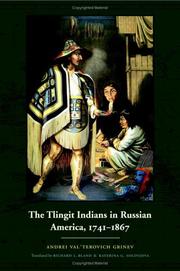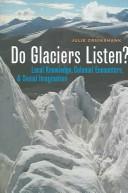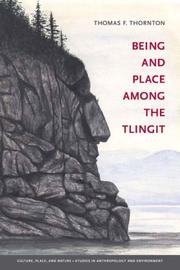| Listing 1 - 10 of 11 | << page >> |
Sort by
|
Book
ISBN: 0295952903 Year: 1973 Publisher: Seattle University of Washington press
Abstract | Keywords | Export | Availability | Bookmark
 Loading...
Loading...Choose an application
- Reference Manager
- EndNote
- RefWorks (Direct export to RefWorks)
Tlingit Indians --- Economic conditions. --- Koloshi Indians --- Koluschan Indians --- Lingít Indians --- Thlinket Indians --- Thlinkithen Indians --- Tlinkit Indians --- Indians of North America --- Economic conditions

ISBN: 1280374470 9786610374472 0803205384 9780803205383 9781280374470 0803222149 9780803222144 6610374473 0803222149 9780803222144 Year: 2005 Publisher: Lincoln University of Nebraska Press
Abstract | Keywords | Export | Availability | Bookmark
 Loading...
Loading...Choose an application
- Reference Manager
- EndNote
- RefWorks (Direct export to RefWorks)
Tlingit Indians --- Koloshi Indians --- Koluschan Indians --- Lingít Indians --- Thlinket Indians --- Thlinkithen Indians --- Tlinkit Indians --- Indians of North America --- Cultural assimilation. --- History.
Book
ISBN: 9781602233713 1602233713 9781602233720 1602233721 9781602233706 1602233705 160223373X Year: 2019 Publisher: Fairbanks, AK
Abstract | Keywords | Export | Availability | Bookmark
 Loading...
Loading...Choose an application
- Reference Manager
- EndNote
- RefWorks (Direct export to RefWorks)
Tlingit Indians --- Indians of North America --- Civil rights --- Koloshi Indians --- Koluschan Indians --- Lingít Indians --- Thlinket Indians --- Thlinkithen Indians --- Tlinkit Indians --- Civil rights. --- Peratrovich, Elizabeth,
Book
ISBN: 0803269773 080326979X 9780803269798 9780803269774 9780803234628 0803234627 9780803269781 0803269781 Year: 2015 Publisher: Lincoln
Abstract | Keywords | Export | Availability | Bookmark
 Loading...
Loading...Choose an application
- Reference Manager
- EndNote
- RefWorks (Direct export to RefWorks)
]]>
Heritage tourism --- Tlingit Indians --- Tour guides (Persons) --- Cicerones --- Docents --- Guides, Tour (Persons) --- Tourist guides (Persons) --- Tourists' guides (Persons) --- Tourism --- Koloshi Indians --- Koluschan Indians --- Lingít Indians --- Thlinket Indians --- Thlinkithen Indians --- Tlinkit Indians --- Indians of North America --- Cultural tourism --- Industries --- Employees
Book
ISBN: 0295806281 0295994894 Year: 2015 Publisher: Seattle : University of Washington Press,
Abstract | Keywords | Export | Availability | Bookmark
 Loading...
Loading...Choose an application
- Reference Manager
- EndNote
- RefWorks (Direct export to RefWorks)
Tlingit Indians --- Potlatch --- Indians of North America --- Funeral customs and rites. --- Funeral customs and rites --- American aborigines --- American Indians --- First Nations (North America) --- Indians of the United States --- Indigenous peoples --- Native Americans --- North American Indians --- Koloshi Indians --- Koluschan Indians --- Lingít Indians --- Thlinket Indians --- Thlinkithen Indians --- Tlinkit Indians --- Culture --- Ethnology --- Social life and customs
Book
ISBN: 080326674X 9780803266742 9780803240568 0803240562 Year: 2015 Publisher: Lincoln
Abstract | Keywords | Export | Availability | Bookmark
 Loading...
Loading...Choose an application
- Reference Manager
- EndNote
- RefWorks (Direct export to RefWorks)
"Sharing Our Knowledge brings together Native elders, tradition bearers, educators, cultural activists, anthropologists, linguists, historians, and museum professionals to explore the culture, history, and language of the Tlingit people of southeast Alaska and their coastal neighbors. These interdisciplinary, collaborative essays present Tlingit culture not as an object of study but rather as a living heritage that continues to inspire and guide the lives of communities and individuals throughout southeast Alaska and northwest British Columbia. This volume focuses on the preservation and dissemination of Tlingit language, traditional cultural knowledge, and history from an activist Tlingit perspective. Sharing Our Knowledge also highlights a variety of collaborations between Native groups and individuals and non-Native researchers, emphasizing a long history of respectful, cooperative, and productive working relations aimed at recording and transmitting cultural knowledge for tribal use and promoting Native agency in preserving heritage. By focusing on these collaborations, the contributors demonstrate how such alliances have benefited the Tlingits and neighboring groups in preserving and protecting their heritage while advancing scholarship at the same time"-- "An edited volume of interdisciplinary, collaborative research on Tlingit culture, language, and history"--
HISTORY / Canada / Post-Confederation (1867-). --- HISTORY / United States / State & Local / West (AK, CA, CO, HI, ID, MT, NV, UT, WY). --- SOCIAL SCIENCE / Ethnic Studies / Native American Studies. --- Indians of North America --- Tlingit art. --- Tlingit Indians --- Koloshi Indians --- Koluschan Indians --- Lingít Indians --- Thlinket Indians --- Thlinkithen Indians --- Tlinkit Indians --- Art, Tlingit --- Art, American --- Art, Canadian --- American aborigines --- American Indians --- First Nations (North America) --- Indians of the United States --- Indigenous peoples --- Native Americans --- North American Indians --- Languages. --- Social life and customs. --- History. --- Art --- Culture --- Ethnology --- Pacific Coast (North America) --- West Coast (North America) --- Western Coast (North America) --- Ethnic relations.
Book
ISBN: 1602232466 9781602232464 9781602232457 1602232458 Year: 2015 Publisher: Fairbanks
Abstract | Keywords | Export | Availability | Bookmark
 Loading...
Loading...Choose an application
- Reference Manager
- EndNote
- RefWorks (Direct export to RefWorks)
"In 1912, Shoki Kayamori and his box camera arrived in a small Tlingit village in southeast Alaska. At a time when Asian immigrants were forbidden to own property and faced intense racial pressure, the Japanese-born Kayamori put down roots and became part of the Yakutat community. For three decades he photographed daily life in the village, turning his lens on locals and migrants alike, and gaining the nickname 'Picture Man.' But as World War II drew near, his passion for photography turned dangerous as government officials called out Kayamori as a potential spy. Despondent, Kayamori committed suicide, leaving behind an enigmatic photographic legacy. In Picture Man, Margaret Thomas views Kayamori's life through multiple lenses. Using Kayamori's original photos, she explores the economic and political realities that sent Kayamori and thousands like him out of Japan toward opportunity and adventure in the United States, especially the Pacific Northwest. She reveals the tensions around Asian immigrants in the West Coast and the racism that sent many young men north to work in the canneries of Alaska. And she illuminates the intersecting--and at times conflicting--lives of villagers and migrants in a time of enormous change. Part history, part biography, part photographic showcase, Picture Man offers a fascinating new view of Alaska history"
Japanese American photographers --- Photographers --- Japanese Americans --- Immigrants --- Emigrants --- Foreign-born population --- Foreign population --- Foreigners --- Migrants --- Persons --- Aliens --- Kibei Nisei --- Nisei --- Ethnology --- Japanese --- Artists --- Photographers, Japanese American --- Kayamori, Shoki, --- Kayamori, Seiki, --- Brauchtum --- Alltag --- Tlingit --- Soziale Situation --- Ethnische Beziehungen --- Japanischer Einwanderer --- Tlingit Indians --- Race relations --- Manners and customs --- Documentary photography --- Social life and customs --- Social conditions --- History --- Alaska --- Kayamori, Shoki --- Yakutat, Alas. --- Yakutat (Alaska) --- Koloshi Indians --- Koluschan Indians --- Lingít Indians --- Thlinket Indians --- Thlinkithen Indians --- Tlinkit Indians --- Indians of North America --- Photography, Documentary --- Photography --- Ceremonies --- Customs, Social --- Folkways --- Social customs --- Traditions --- Usages --- Civilization --- Etiquette --- Rites and ceremonies --- Integration, Racial --- Race problems --- Race question --- Relations, Race --- Social problems --- Sociology --- Ethnic relations --- Minorities --- Racism --- Â-lâ-sṳ̂-kâ --- AK --- Alaasika --- ʻĀlaka --- Alasca --- Alasijia --- Alasijia Zhou --- Alaska Eyâleti --- Alaska osariik --- Alaska Territory --- Alasḳah --- Alasko --- Alaszka --- Ali︠a︡sk --- Ali︠a︡ska --- Aljaška --- Allaesŭkʻa --- Allaesŭkʻa-ju --- Allaesŭkʻaju --- Alyaska --- Alyaska Shitati --- Arasuka --- Arasuka-shū --- Arasukashū --- Civitas Alascae --- Estado de Alaska --- Estado ng Alaska --- Hakʼaz Dineʼé Bikéyah Hahoodzo --- Medinat Alasḳah --- Politeia tēs Alaska --- Russian America --- Russkai︠a︡ Amerika --- Shtat Ali︠a︡ska --- State of Alaska --- Statul Alaska --- Territory of Alaska --- Πολιτεία της Αλάσκα --- Αλάσκα --- Аљаска --- Аляск --- Аляска --- Алјаска --- Русская Америка --- Штат Аляска --- אלאסקע --- אלסקה --- מדינת אלסקה --- アラスカ --- アラスカ州 --- 阿拉斯加 --- 阿拉斯加州 --- 알래스카 --- 알래스카 주 --- 알래스카주 --- Yakutat, Alaska --- Yakutat City and Borough (Alaska) --- Yakutat Borough (Alaska) --- City & Borough of Yakutat (Alaska) --- City and Borough of Yakutat (Alaska) --- Yakutat City (Alaska) --- Yukutat (Alaska) --- Einwanderer --- Japaner --- Ethnische Beziehung --- Rassenbeziehung --- Rassenbeziehungen --- Soziale Lage --- Soziale Verhältnisse --- Soziallage --- Sozialverhältnisse --- Soziale Bedingungen --- Situation --- Soziale Stellung --- Lebensbedingungen --- Tlinkit --- Nordwestküstenindianer --- Alltagsphänomen --- Alltagsleben --- Alltagswelt --- Lebensweise --- Tägliches Leben --- Daily Life --- Privatleben --- Lebenswelt --- Alltagskultur --- Volksbrauch --- Bräuche --- Volksbrauchtum --- Volksbräuche --- Sitte --- Volkskultur --- Kayamori, Seiki --- Fotograf --- Hilfsarbeiter --- 1877-1941 --- 09.06.1877-09.12.1941 --- Â-lâ-sṳ̂-k --- Ali͡ask --- Ali͡aska --- Arasuka-sh --- Arasukash --- Russkai͡a Amerika --- Shtat Ali͡aska

ISBN: 0295985135 0295985143 0774811862 9780295985138 9780295985145 9780774811873 0774811870 9780774811866 9780774851404 Year: 2005 Publisher: Vancouver Seattle UBC Press University of Washington Press
Abstract | Keywords | Export | Availability | Bookmark
 Loading...
Loading...Choose an application
- Reference Manager
- EndNote
- RefWorks (Direct export to RefWorks)
"Do Glaciers Listen? explores the conflicting depictions of glaciers to show how natural and cultural histories are objectively entangled in the Mount Saint Elias ranges. This rugged area, where Alaska, British Columbia, and the Yukon Territory now meet, underwent significant geophysical change in the late eighteenth and nineteenth centuries, which coincided with dramatic social upheaval resulting from European exploration and increased travel and trade among Aboriginal peoples." "Focusing on contrasting views during the late stages of the Little Ice Age (1550-1900), Cruikshank demonstrates how local knowledge is produced, rather than discovered, through colonial encounters, and how it often conjoins social and biophysical processes. She then traces how the divergent views weave through contemporary debates about cultural meanings as well as current discussions about protected areas, parks, and the new World Heritage site. Readers interested in anthropology and Native and northern studies will find this a rich addition to circumpolar literature."--Jacket.
Tlingit Indians --- Athapascan Indians --- Glaciers --- Ice fields --- Human ecology --- Tlingit (Indiens) --- Athapascan (Indiens) --- Champs de glace --- Ecologie humaine --- Saint Elias Mountains --- Saint-Elias, Monts --- Discovery and exploration. --- Découverte et exploration --- Oral tradition --- Fields, Ice --- Icefields --- Cryosphere --- Ice --- Glaciology --- Meltwater --- Athabascan Indians --- Athabaskan Indians --- Athapaskan Indians --- Indians of North America --- Koloshi Indians --- Koluschan Indians --- Lingít Indians --- Thlinket Indians --- Thlinkithen Indians --- Tlinkit Indians --- Coast Ranges --- Environmental conditions. --- Tradition, Oral --- Oral communication --- Folklore --- Oral history --- Ecology --- Environment, Human --- Human beings --- Human environment --- Ecological engineering --- Human geography --- Nature --- Social aspects --- Effect of environment on --- Effect of human beings on --- Discovery and exploration --- Environmental conditions --- #SBIB:39A5 --- Kunst, habitat, materiële cultuur en ontspanning --- Tlingit Indians - Saint Elias Mountains - Folklore --- Athapascan Indians - Saint Elias Mountains - Folklore --- Glaciers - Saint Elias Mountains - Folklore --- Ice fields - Saint Elias Mountains - Folklore --- Human ecology - Saint Elias Mountains --- Oral tradition - Saint Elias Mountains --- Saint Elias Mountains - Discovery and exploration --- Saint Elias Mountains - Folklore --- Saint Elias Mountains - Environmental conditions --- Glaciers in literature --- Climatic changes --- Changes, Climatic --- Changes in climate --- Climate change --- Climate change science --- Climate changes --- Climate variations --- Climatic change --- Climatic fluctuations --- Climatic variations --- Global climate changes --- Global climatic changes --- Climatology --- Climate change mitigation --- Global environmental change --- Teleconnections (Climatology) --- Environmental aspects

ISBN: 0295800402 9780295800400 9780295987491 0295987499 9780295997179 Year: 2008 Publisher: Seattle Juneau [Alaska]
Abstract | Keywords | Export | Availability | Bookmark
 Loading...
Loading...Choose an application
- Reference Manager
- EndNote
- RefWorks (Direct export to RefWorks)
"In Being and Place among the Tlingit, place signifies a specific geographical location and also reveals the ways in which individuals and social groups define themselves. The notion of place consists of three dimensions - space, time, and experience - which are culturally and environmentally structured. Thomas Thornton examines each in detail to show how individual and collective Tlingit notions of place, being, and identity are formed. As he observes, despite cultural and environmental changes over time, particularly in the post-contact era since the late eighteenth century, Tlingits continue to bind themselves and their culture to places and landscapes in distinctive ways."--Jacket.
Geographical perception --- Cultural property --- Names, Geographical --- Tlingit Indians --- Environmental perception --- Maps, Mental --- Mental maps --- Perceptual cartography --- Perceptual maps --- Perception --- Orientation (Psychology) --- Space perception --- Cultural heritage --- Cultural patrimony --- Cultural resources --- Heritage property --- National heritage --- National patrimony --- National treasure --- Patrimony, Cultural --- Treasure, National --- Property --- World Heritage areas --- Geographic names --- Geographical names --- Place names --- Placenames --- Toponyms --- Names --- Geography --- Toponymy --- Koloshi Indians --- Koluschan Indians --- Lingít Indians --- Thlinket Indians --- Thlinkithen Indians --- Tlinkit Indians --- Indians of North America --- Social aspects --- Social life and customs. --- Alaska --- Â-lâ-sṳ̂-kâ --- AK --- Alaasika --- ʻĀlaka --- Alasca --- Alasijia --- Alasijia Zhou --- Alaska Eyâleti --- Alaska osariik --- Alasḳah --- Alasko --- Alaszka --- Ali︠a︡sk --- Ali︠a︡ska --- Aljaška --- Allaesŭkʻa --- Allaesŭkʻa-ju --- Allaesŭkʻaju --- Alyaska --- Alyaska Shitati --- Arasuka --- Arasuka-shū --- Arasukashū --- Civitas Alascae --- Estado de Alaska --- Estado ng Alaska --- Hakʼaz Dineʼé Bikéyah Hahoodzo --- Medinat Alasḳah --- Politeia tēs Alaska --- Russian America --- Russkai︠a︡ Amerika --- Shtat Ali︠a︡ska --- State of Alaska --- Statul Alaska --- Territory of Alaska --- Πολιτεία της Αλάσκα --- Αλάσκα --- Аљаска --- Аляск --- Аляска --- Алјаска --- Русская Америка --- Штат Аляска --- אלאסקע --- אלסקה --- מדינת אלסקה --- アラスカ --- アラスカ州 --- 阿拉斯加 --- 阿拉斯加州 --- 알래스카 --- 알래스카 주 --- 알래스카주 --- Alaska Territory
Book
ISBN: 0295999608 9780295999609 9780295999593 0295999594 Year: 2017 Publisher: Seattle
Abstract | Keywords | Export | Availability | Bookmark
 Loading...
Loading...Choose an application
- Reference Manager
- EndNote
- RefWorks (Direct export to RefWorks)
"In her first book, Blonde Indian, Ernestine Hayes powerfully recounted the story of coming back to Juneau and to her Tlingit home after many years of wandering. The Tao of Raven takes up the next and in some ways more interesting question: once the exile returns, then what? Using motifs from the story Raven and the Box of Daylight to deepen her narration and reflection, Hayes expresses an ongoing frustration and anger at the obstacles and prejudices still facing Alaska Natives in their own land, but also recounts her own story of attending and completing college in her fifties and becoming a professor and a writer. Now seventy years old and thinking very much of the generations who will come after her, Hayes speaks for herself but also has powerful things to say about the possibilities and complications of her Native community --
Tlingit Indians --- Tlingit women --- Women college teachers --- Homecoming --- Koloshi Indians --- Koluschan Indians --- Lingít Indians --- Thlinket Indians --- Thlinkithen Indians --- Tlinkit Indians --- Indians of North America --- Coming home --- Home-coming --- Travel --- Women as college teachers --- College teachers --- Women in higher education --- Women teachers --- Women, Tlingit --- Women --- Social life and customs. --- Social conditions. --- Hayes, Ernestine, --- Alaska --- Â-lâ-sṳ̂-kâ --- AK --- Alaasika --- ʻĀlaka --- Alasca --- Alasijia --- Alasijia Zhou --- Alaska Eyâleti --- Alaska osariik --- Alasḳah --- Alasko --- Alaszka --- Ali︠a︡sk --- Ali︠a︡ska --- Aljaška --- Allaesŭkʻa --- Allaesŭkʻa-ju --- Allaesŭkʻaju --- Alyaska --- Alyaska Shitati --- Arasuka --- Arasuka-shū --- Arasukashū --- Civitas Alascae --- Estado de Alaska --- Estado ng Alaska --- Hakʼaz Dineʼé Bikéyah Hahoodzo --- Medinat Alasḳah --- Politeia tēs Alaska --- Russian America --- Russkai︠a︡ Amerika --- Shtat Ali︠a︡ska --- State of Alaska --- Statul Alaska --- Territory of Alaska --- Πολιτεία της Αλάσκα --- Αλάσκα --- Аљаска --- Аляск --- Аляска --- Алјаска --- Русская Америка --- Штат Аляска --- אלאסקע --- אלסקה --- מדינת אלסקה --- アラスカ --- アラスカ州 --- 阿拉斯加 --- 阿拉斯加州 --- 알래스카 --- 알래스카 주 --- 알래스카주 --- Alaska Territory --- Women college teachers. --- Tlingit women. --- Tlingit Indians. --- Homecoming. --- Descriptive sociology --- Social conditions --- Social history --- History --- Sociology --- Social life and customs --- Hayes, Ernestine --- Alaska. --- Â-lâ-sṳ̂-k --- Ali͡ask --- Ali͡aska --- Arasuka-sh --- Arasukash --- Russkai͡a Amerika --- Shtat Ali͡aska
| Listing 1 - 10 of 11 | << page >> |
Sort by
|

 Search
Search Feedback
Feedback About UniCat
About UniCat  Help
Help News
News